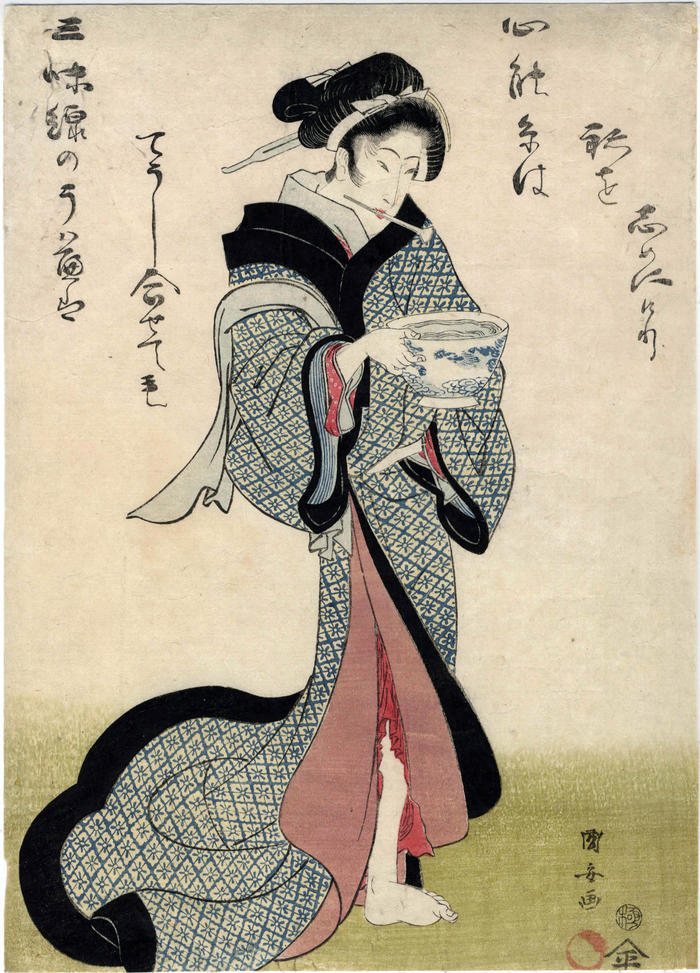Utagawa Kuniyasu (歌川国安) (artist 1794 – 1832)
Morning routine of a beautiful woman from an untitled series of bijin accompanied by poems
1818 – 1830
9.75 in x 13.5 in (Overall dimensions) Japanese color woodblock print
Signed: Kuniyasu ga (国安画)
Artist's seal: toshidama
Publisher: Ōmiya Heihachi
(Marks 413 seal 01-108)
Censor's seal: kiwame
Museum of Fine Arts, Boston - another print from this series
Ritsumeikan University - another print from this series in black and white
Nationaal Museum van Wereldculturen (Rijksmuseum Volkenkunde, Leiden) - via Ritsumeikan University Courtesan in casual robe with toothbrush and water bowl. Text is a humorous kyōka poem.
This poem reads from the far left to the right: 三味綿のうはへはてうし合せても心の糸はねをしめにけ. (Shamisen no uwabe ha chōshi awasete mo kokoro no ito ha no o shimenikeri). According to the Rijksmuseum voor Volkenkunde, Leiden this translates as 'Even though at first sight the shamisen seems to agree in the music, the strings of her heart strain her mind.'
****
Illustrated in color in 原色浮世絵大百科事典 (Genshoku Ukiyoe Daihyakka Jiten), vol. 8, #292, p. 119.
****
Another copy of this print can be found in the Rijksmuseum voor Volkenkunde, Leiden (RV-1-4469-x5). According to the curatorial files the woman is carrying a fusayōji (房楊枝) or kind of toothbrush between her teeth. It is described as being an "Edo-period toothbrush resembling a large toothpick burred at one end into a tuft".
****
There is another print from this series from the Erich Gross collection in Switzerland that is illustrated on page 254 or Japanese Woodblock Prints by Andreas Marks, 2010.
****
In a scholarly article on dental hygiene, 'The miswak (Salvadora persica L.) chewing stick: Cultural implications in oral health promotion' by Basil H. Aboul-Enein it says:
"3.1. Salvadora persica (miswak chewing stick)
Chewing sticks, though the term may be a misnomer considering that the stick is chewed only briefly to fray the fibers which is then used as a brush, are obtained from a variety of plant species and have been traditionally used for cleaning teeth in Africa, Asia, Latin America, and the Near East. Chewing sticks are known by different names in different cultures: miswak in Arabic, koyoji in Japanese, qesam in Hebrew, mastic in Latin, Mefaka in Amharic, and Datun in Hindi. The spread of Islamic culture had a profound influence on the propagation and use of Miswak, which as noted earlier was a pre-Islamic custom that was adhered to by the Arabs to get their teeth cleaned. The use of miswak has also been reflected in classical Arab poetry where it stands as a symbol for white teeth and fragrant mouth. The Persian physician Abu Bakr Al-Razi, known in the West as Rhazes, had remarked that miswak was “good for the foul breath of the mouth, polishes the teeth, and strengthens the gums”. "
Ōmiya Heihachi (近江屋平八) (publisher)
beautiful women (bijin-ga - 美人画) (genre)
